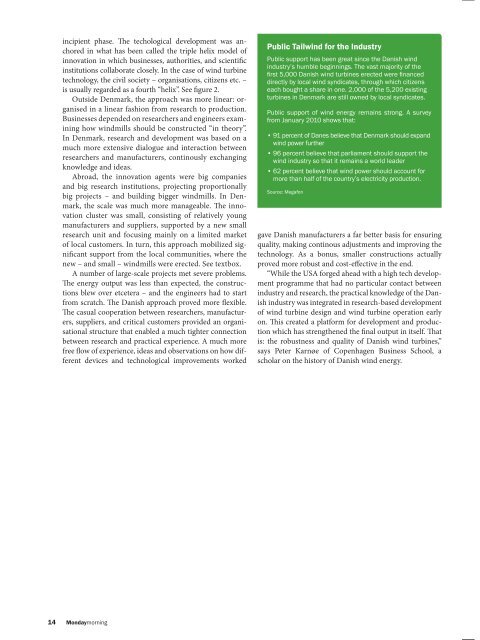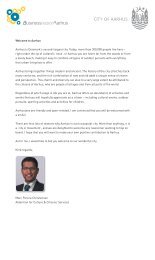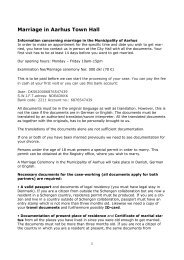Aarhus – Capital of Wind Energy - Aarhus.dk
Aarhus – Capital of Wind Energy - Aarhus.dk
Aarhus – Capital of Wind Energy - Aarhus.dk
- No tags were found...
Create successful ePaper yourself
Turn your PDF publications into a flip-book with our unique Google optimized e-Paper software.
incipient phase. The techological development was anchoredin what has been called the triple helix model <strong>of</strong>innovation in which businesses, authorities, and scientificinstitutions collaborate closely. In the case <strong>of</strong> wind turbinetechnology, the civil society <strong>–</strong> organisations, citizens etc. <strong>–</strong>is usually regarded as a fourth “helix”. See figure 2.Outside Denmark, the approach was more linear: organisedin a linear fashion from research to production.Businesses depended on researchers and engineers examininghow windmills should be constructed “in theory”.In Denmark, research and development was based on amuch more extensive dialogue and interaction betweenresearchers and manufacturers, continously exchangingknowledge and ideas.Abroad, the innovation agents were big companiesand big research institutions, projecting proportionallybig projects <strong>–</strong> and building bigger windmills. In Denmark,the scale was much more manageable. The innovationcluster was small, consisting <strong>of</strong> relatively youngmanufacturers and suppliers, supported by a new smallresearch unit and focusing mainly on a limited market<strong>of</strong> local customers. In turn, this approach mobilized significantsupport from the local communities, where thenew <strong>–</strong> and small <strong>–</strong> windmills were erected. See textbox.A number <strong>of</strong> large-scale projects met severe problems.The energy output was less than expected, the constructionsblew over etcetera <strong>–</strong> and the engineers had to startfrom scratch. The Danish approach proved more flexible.The casual cooperation between researchers, manufacturers,suppliers, and critical customers provided an organisationalstructure that enabled a much tighter connectionbetween research and practical experience. A much morefree flow <strong>of</strong> experience, ideas and observations on how differentdevices and technological improvements workedPublic Tailwind for the IndustryPublic support has been great since the Danish windindustry’s humble beginnings. The vast majority <strong>of</strong> thefirst 5,000 Danish wind turbines erected were financeddirectly by local wind syndicates, through which citizenseach bought a share in one. 2,000 <strong>of</strong> the 5,200 existingturbines in Denmark are still owned by local syndicates.Public support <strong>of</strong> wind energy remains strong. A surveyfrom January 2010 shows that:• 91 percent <strong>of</strong> Danes believe that Denmark should expandwind power further• 96 percent believe that parliament should support thewind industry so that it remains a world leader• 62 percent believe that wind power should account formore than half <strong>of</strong> the country’s electricity production.Source: Megafongave Danish manufacturers a far better basis for ensuringquality, making continous adjustments and improving thetechnology. As a bonus, smaller constructions actuallyproved more robust and cost-effective in the end.“While the USA forged ahead with a high tech developmentprogramme that had no particular contact betweenindustry and research, the practical knowledge <strong>of</strong> the Danishindustry was integrated in research-based development<strong>of</strong> wind turbine design and wind turbine operation earlyon. This created a platform for development and productionwhich has strengthened the final output in itself. Thatis: the robustness and quality <strong>of</strong> Danish wind turbines,”says Peter Karnøe <strong>of</strong> Copenhagen Business School, ascholar on the history <strong>of</strong> Danish wind energy.Cargo Service<strong>–</strong> the wind turbine expert in Port <strong>of</strong> <strong>Aarhus</strong>During the last couple <strong>of</strong> decades Cargo Service hasgained unique experience and expertise within loadingand handling <strong>of</strong> wind turbines and components. Eachyear the stevedore company is loading in average 80vessels with wind turbines and with a total weight <strong>of</strong>about 120.000 metric tons.Now Cargo Service is allocating additional focus andstrategic attention to the wind energy business segment.Having transferred the container activities to a new jointventure company Cargo Service is now ready to expandits wind turbine activities.Efficient and customised solutionsBy merging the two container terminals in Port <strong>of</strong><strong>Aarhus</strong>, Cargo Service is releasing an area <strong>of</strong> 100-150.000square meters, which is ideal for handling and storing thelarge wind turbine projects.may have covering loading, handling and storing <strong>of</strong> windturbines and components.Quality AssuranceCargo Service is currently in the process <strong>of</strong> developing a newQuality Assurance system for its wind power customers.- We will be able to <strong>of</strong>fer our customers a very thoroughquality check <strong>of</strong> all wind turbine components. Thecustomers will get a comprehensive quality documentationand they will be <strong>of</strong>fered the convenience <strong>of</strong> following eachcomponent/project online from reception to shipping,explains Lars Krabbe.OffshoreCargo Service has primarily been handling onshorewind turbines. Going forward however the <strong>of</strong>fshore windturbines will also be in focus.- The location in continuation <strong>of</strong> the container quay inPort <strong>of</strong> <strong>Aarhus</strong> is optimal. Back to back location withthe quay and the very efficient cranes provide us withprime working conditions. We are capable <strong>of</strong> handlingpractically any lift you can think <strong>of</strong>. With the heavylift crane we can handle single lifts <strong>of</strong> up to 182 metrictons in a range <strong>of</strong> 47 meters, says Lars Krabbe, ChiefCommercial Officer at Cargo Service A/S and adds:- With a unique location in a large port, an extensiveknow-how and all the necessary special equipment andmachinery, we can provide the wind energy industry withefficient and customised solutions <strong>of</strong> any project they- The <strong>of</strong>fshore turbines are assembled onshore and witha blade diameter <strong>of</strong> 120 m they obviously require a largeamount <strong>of</strong> vacant land. That is solved with the newlyreleased area. Furthermore Port <strong>of</strong> <strong>Aarhus</strong> is strategicallywell positioned in regards to the projected <strong>of</strong>fshore windpower plants in the Baltic Sea, says Lars Krabbe.He forecasts that Cargo Service will be involved in part <strong>of</strong>the Anholt project where 111 <strong>of</strong>fshore wind turbines willbe erected and connect by the end <strong>of</strong> 2012.www.cargoservice.<strong>dk</strong>14 Mondaymorning




